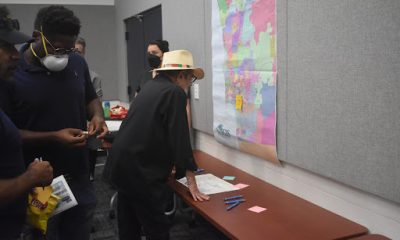Business
These tax tips can make filing (1040) EZ: Sponsored content from JPMorgan Chase & Co. Kelly Perez
With Tax Day approaching, there’s no time like the present to get started on your 2022 returns and submit them well before the April 18 deadline. This year, you have a few extra days to complete your taxes. With the typical deadline of April 15 falling on a weekend, followed by Emancipation Day on Monday, this year’s filing date is on Tuesday, April 18.

With Tax Day approaching, there’s no time like the present to get started on your 2022 returns and submit them well before the April 18 deadline.
This year, you have a few extra days to complete your taxes. With the typical deadline of April 15 falling on a weekend, followed by Emancipation Day on Monday, this year’s filing date is on Tuesday, April 18.
“Though there are a few extra days to file, make sure to still give yourself ample time to gather and organize your tax information to take advantage of any and all tax deductions, or other tax breaks that may apply to you and your family,” says Kelly Perez, Wealth Advisor for J.P. Morgan Private Bank. “Many key deductions that may reduce your tax bill or provide a refund are often left on the table due to lack of preparation. Whether you file on your own or work with a paid tax professional, the initial groundwork is the key to maximizing your benefits.”
Ready to submit or get started? Here are some tips to help simplify the process, maximize your potential refund or minimize your tax burden before you finalize your return.
- Get organized. Make sure you have important documents like last year’s return, current W-2s, 1099s and mortgage interest statements on hand. You’ll also want to gather receipts for tax-deductible purchases, travel, charitable contributions and other potential write-offs. You can look online to find checklists of documents you might need to help you file.
- Be aware of tax law changes. While taxes are inevitable, what you may owe or get refunded might not be. As you finalize or start your 2022 tax return, be aware of changes to federal, state and local tax laws that could affect your refund or how much you owe. For example, if you benefited from the child tax credit, earned income tax credit or child and dependent care credit on your 2021 return, don’t be surprised if you get a smaller refund this year. Credits expanded as part of federal Covid relief packages have now returned to pre-pandemic levels.
- Are you working from home permanently? If you have a home-based business, you might qualify for a home office tax deduction. You can potentially write off expenses for a part of your home you only use for business purposes.
- To itemize or not to itemize. Determine whether you’ll itemize your expenses or take the standard deduction. If you think your qualified expenses will be more than the 2022 standard deduction ($12,950 for most singles and $25,900 for most married couples filing jointly), it might be worth it to itemize. Taking the standard deduction can make the filing process easier, but it could mean you pay more in taxes or receive a smaller refund.
- Contribute to retirement accounts. You can fund a traditional or Roth IRA through the April 18, 2023, tax filing deadline and have it count for 2022. Traditional IRA contributions lower your tax bill right now, while your Roth IRA withdrawals are tax-free in retirement. You can contribute up to $6,000 to an IRA each year, or — if you were 50 years or older in 2022 — up to $7,000 of your earned income.
- Seek help when you need it. If you have a more comprehensive tax return, it can be a good idea to work with a certified public accountant (CPA). If you need assistance in general, check if you qualify for free in-person or remote programs offered by the IRS or local organizations depending on your income, age and disability status.
- Go faster by going digital. Filing electronically will get your return to you more quickly than filing by mail. Selecting direct deposit to a bank account or prepaid card will make the process even faster.
- Need more time? If you can’t file by April 18, you can fill out a Form 4868 that will extend your filing deadline to Oct. An extension to file isn’t an extension to pay, so if you think you’ll owe, plan to submit an estimated payment amount when you file your extension.
The bottom line – Filing your taxes doesn’t have to be difficult. Getting organized now will help make tax season easier this year and put you in better shape for years to come. For more tips to help you make the most of you and your family’s finances, visit J.P. Morgan’s U.S. Tax Center at privatebank.jpmorgan.com/gl/en/insights/planning/us-tax-center.
Activism
Oakland Post: Week of April 17 – 23, 2024
The printed Weekly Edition of the Oakland Post: Week of April 17 – 23, 2024

To enlarge your view of this issue, use the slider, magnifying glass icon or full page icon in the lower right corner of the browser window. ![]()
Business
V.P. Kamala Harris: Americans With Criminal Records Will Soon Be Eligible for SBA Loans
Speaking in Las Vegas on Jan. 27, Vice President Kamala Harris announced a forthcoming federal rule that will extend access to Small Business Administration (SBA) loans to Americans who have been convicted of felonies but have served their time. Small business owners typically apply for the SBA loans to start or sustain their businesses.

By California Black Media
Speaking in Las Vegas on Jan. 27, Vice President Kamala Harris announced a forthcoming federal rule that will extend access to Small Business Administration (SBA) loans to Americans who have been convicted of felonies but have served their time.
Small business owners typically apply for the SBA loans to start or sustain their businesses.
Harris thanked U.S. Rep. Steven Horsford (D-NV-04), the chair of the Congressional Black Caucus, for the work he has done in Washington to support small businesses and to invest in people.
“He and I spent some time this afternoon with business leaders and small business leaders here in Nevada. The work you have been doing to invest in community and to invest in the ambition and natural capacity of communities has been exceptional,” Harris said, speaking to a crowd of a few hundred people at the Brotherhood of Electrical Workers Hall in East Las Vegas.
On her daylong trip, Harris was joined by Horford, SBA Administrator Isabella Guzman, Interim Under Secretary of Commerce for Minority Business Development Agency (MBDA) Eric Morrissette, and Sen. Catherine Cortez Masto (D-Nev).
“Formerly incarcerated individuals face significant barriers to economic opportunity once they leave prison and return to the community, with an unemployment rate among the population of more than 27%,” the White House press release continued. “Today’s announcement builds on the Vice President’s work to increase access to capital. Research finds that entrepreneurship can reduce recidivism for unemployed formerly incarcerated individuals by as much as 30%.”
Business
G.O.P. Lawmakers: Repeal AB 5 and Resist Nationalization of “Disastrous” Contractor Law
Republican lawmakers gathered outside of the Employee Development Department in Sacramento on Jan. 23 to call for the repeal of AB5, the five-year old California law that reclassified gig workers and other independent contractors as W-2 employees under the state’s labor code.

By California Black Media
Republican lawmakers gathered outside of the Employee Development Department in Sacramento on Jan. 23 to call for the repeal of AB5, the five-year old California law that reclassified gig workers and other independent contractors as W-2 employees under the state’s labor code.
Organizers said they also held the rally to push back against current efforts in Washington to pass a similar federal law.
“We are here to talk about this very important issue – a battle we have fought for many years – to stop this disastrous AB 5 policy,” said Assembly Republican Leader James Gallagher (R-Yuba City).
Now, that threat has gone national as we have seen this new rule being pushed out of the Biden administration,” Gallagher continued.
On Jan. 10, the U.S. Department of Labor issued a new rule providing guidance on “on how to analyze who is an employee or independent contractor under the Fair Labor Standards Act (FLSA).”
“This final rule rescinds the Independent Contractor Status Under the Fair Labor Standards Act rule (2021 IC Rule), that was published on January 7, 2021, and replaces it with an analysis for determining employee or independent contractor status that is more consistent with the FLSA as interpreted by longstanding judicial precedent,” a Department of Labor statement reads.
U.S. Congressmember Kevin Kiley (R-CA-3), who is a former California Assemblymember, spoke at the rally.
“We are here today to warn against the nationalization of one of the worst laws that has ever been passed in California, which has devastated the livelihoods of folks in over 600 professions,” said Kiley, adding that the law has led to a 10.5% decline in self-employment in California.
Kiley blamed U.S Acting Secretary of Labor, July Su, who was the former secretary of the California Labor and Workforce Development Agency, for leading the effort to redefine “contract workers” at the federal level.
Kiley said two separate lawsuits have been filed against Su’s Rule – its constitutionality and the way it was enacted, respectively. He said he is also working on legislation in Congress that puts restrictions on the creation and implementation of executive branch decisions like Su’s.
Assemblymember Kate Sanchez (R-Rancho Santa Margarita) announced that she plans to introduce legislation to repeal AB 5 during the current legislative session.
“So many working moms like myself, who are also raising kids, managing households, were devastated by the effects of AB 5 because they lost access to hundreds of flexible professions,” Sanchez continued. “I’ve been told by many of these women that they have lost their livelihoods as bookkeepers, artists, family caregivers, designers, and hairstylists because of this destructive law.”
-

 Activism4 weeks ago
Activism4 weeks agoOakland Post: Week of March 20 – 26, 2024
-

 #NNPA BlackPress3 weeks ago
#NNPA BlackPress3 weeks agoCOMMENTARY: D.C. Crime Bill Fails to Address Root Causes of Violence and Incarceration
-

 #NNPA BlackPress3 weeks ago
#NNPA BlackPress3 weeks agoMayor, City Council President React to May 31 Closing of Birmingham-Southern College
-

 #NNPA BlackPress3 weeks ago
#NNPA BlackPress3 weeks agoCOMMENTARY: Lady Day and The Lights!
-

 #NNPA BlackPress3 weeks ago
#NNPA BlackPress3 weeks agoFrom Raids to Revelations: The Dark Turn in Sean ‘Diddy’ Combs’ Saga
-

 #NNPA BlackPress3 weeks ago
#NNPA BlackPress3 weeks agoBaltimore Key Bridge Catastrophe: A City’s Heartbreak and a Nation’s Alarm
-

 #NNPA BlackPress3 weeks ago
#NNPA BlackPress3 weeks agoBaltimore’s Key Bridge Struck by Ship, Collapses into Water
-

 Activism3 weeks ago
Activism3 weeks agoOakland Post: Week of March 27 – April 2, 2024




















































